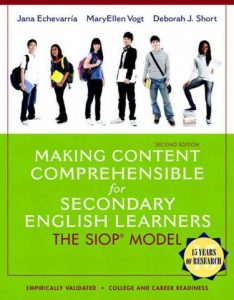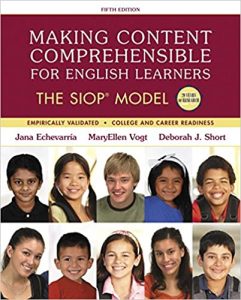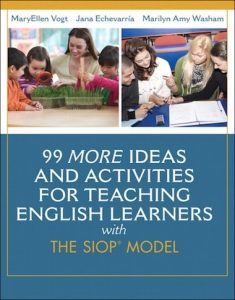Listed below are selected resources for teachers related to working with English Language Learners.
Making content comprehensible for secondary English learners: the SIOP model
by Jana Echevarría
This book is written to give middle and secondary school teachers lesson plans, teaching ideas, and many effective activities for working successfully with adolescents who are English learners or who struggle with academic literacy. Several sample lessons and activities show the alignment of the SIOP Model to the Common Core State Standards (CCSS). Based on research that confirms that the SIOP Model (Sheltered Instruction Observation Protocol) makes a positive difference academically for all students-and what works well for English learners will work equally well with other students-the book is ideal both for teachers who are already familiar with the SIOP Model, and those who are just learning about it. It gives educators a model for planning and implementing lessons that help the English learners in their charge gain access to grade-level content standards, and ultimately prepare them for life after high school, in college or a career.
Making content comprehensible for English learners: the SIOP Model
by Jana Echevarría
“This book introduces and explains the SIOP® (Sheltered Instruction Observation Protocol) Model, a comprehensive, coherent, research-validated model of sheltered instruction, no implemented in districts throughout all 50 states and in multiple countries and territories. The SIOP Model improves teaching effectiveness and results in academic gains for students.”–From the back cover.
99 more ideas and activities for teaching English learners with the SIOP® model
by MaryEllen Vogt
The SIOP ® model is proven to be one of the most effective methods of teaching our English learners. Now teaching with SIOP is even easier with the second volume of Vogt, Echevarria, and Washam’s 99 MORE Ideas and Activities for Teaching English Learners with the SIOP ® Model. Offering brand new, classroom-ready activities, this indispensable resource revisits SIOP ® and shows how to use it each day in the classroom. Whether searching for activities that build vocabulary, keep students highly engaged, or make content concepts clear, these teacher-tested strategies adhere to SIOP ® principles and reinforce best practice. Chapters are organized around SIOP’s eight components and thirty features, so teachers learn not only what activities to try, but also why they work.
 Teaching ELLs Across Content Areas: Issues and Strategies
Teaching ELLs Across Content Areas: Issues and Strategies
edited by Nan Li
Grades: K-12
This book gathers professional knowledge, expertise, and experience from authors who represent the entire range of content areas, including language arts, science, mathematics, technology, arts, psychology, and Hispanic studies.
 50 Strategies for Teaching English Language Learners
50 Strategies for Teaching English Language Learners
by Adrienne L. Herrell & Michael Jordan
Grades: K-12
This book provides an assortment of practical strategies aligned to TESOL standards, each including a brief explanation, step-by-step instructions on how to plan and use the strategy, and classroom scenarios demonstrating how the strategy can be adapted for different grade levels and content areas. Additional strategies in language and literacy development, technology, and assessment are also included.
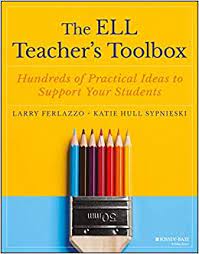 The ELL teacher’s toolbox: Hundreds of practical ideas to support your students
The ELL teacher’s toolbox: Hundreds of practical ideas to support your students
by Larry Ferlazzo & Katie Hull Sypnieski
Grades: K-12
The ELL Teacher’s Toolbox provides hundreds of innovative and research-based instructional strategies you can use to support all levels of English Language Learners….[T]he book is divided into two main sections: Reading/Writing and Speaking/Listening. Each of those sections includes “Top Ten” favorites and between 40 and 70 strategies that can be used as part of multiple lessons and across content areas.
 IEPs for ELs and Other Diverse Learners
IEPs for ELs and Other Diverse Learners
by John J. Hoover & James R. Patton
Grades: K-12
Individualized Education Programs (IEPs) are fundamental for guiding the educational process of and developing goals for students who require special education services. This book guides educators through the process for creating high-quality IEPs for both English learners (ELs) and for students with learning, emotional, or behavioral disabilities.
 Best Practices in ELL Instruction
Best Practices in ELL Instruction
edited by Guofang Li and Patricia A. Edwards
Grades: K-12
Provides best-practice guidelines for targeting reading, writing, oral language, vocabulary, content-domain literacies, and other core skill areas; assessing culturally and linguistically diverse students; and building strong school-home-community partnerships. Chapters include clear-cut recommendations for teaching adolescent ELLs and those with learning disabilities.
 No More Low Expectations for English Learners
No More Low Expectations for English Learners
by Julie Nora and Jana Echevarria
Grades: K-12
Nora and Echevarria describe what best practice methods for supporting ELs’ academic achievement look like, and offer strategies to provide the instructional supports ELs need for both language acquisition and content-area learning.
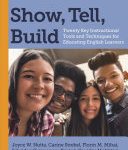 Show, tell, build: Twenty key instructional skills and techniques for educating English learners
Show, tell, build: Twenty key instructional skills and techniques for educating English learners
by Joyce W. Nutta et al.
Grades: K-12
This book is organized around two decision maps for planning and implementing differentiated instruction for ELs: the Academic Subjects Protocol (for teachers of academic subjects) and the Language Arts Protocol (for teachers of language arts). The instructional tools and techniques described in each chapter help teachers provide communication support for ELs through showing and telling, and develop students’ language proficiency through building their skills.
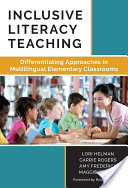 Inclusive literacy teaching: Differentiating approaches in multilingual elementary classrooms
Inclusive literacy teaching: Differentiating approaches in multilingual elementary classrooms
by Lori Helman et al.
Grades: 1-6
The authors present key foundational principles in language and literacy development for linguistically diverse students. They demonstrate both a “big picture” and an “up close and personal” look at the successes, obstacles, and developmental nuances for students learning to read and write in a new language in inclusive classrooms. (E-book)
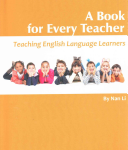 A book for every teacher: Teaching English language learners
A book for every teacher: Teaching English language learners
by Nan Li
Grades: K-12
The book is designed for all teachers who have or will have ELLs in their classrooms and who seek information and strategies to better work with and serve their ELLs to achieve academic success. With this design, teachers can use the book as a text or reference tool, or for professional development materials.
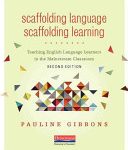 Scaffolding language, scaffolding learning: Teaching English language learners in the mainstream classroom
Scaffolding language, scaffolding learning: Teaching English language learners in the mainstream classroom
by Pauline Gibbons
Grades: K-6
With clear directions and classroom tested strategies for supporting students’ academic progress, the author shows how the teaching of language can be integrated seamlessly with the teaching of content. Examples of classroom discourse illustrate how the scaffolding process works, while activities to facilitate conversation and higher-level thinking put the latest research on second language learning into action.
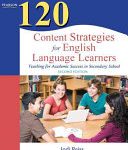 120 content strategies for English language learners: Teaching for academic success in secondary school
120 content strategies for English language learners: Teaching for academic success in secondary school
by Jodi Reiss
Grades: 9-12
Offers practical instructional and assessment strategies built on a foundation of second language acquisition theories and principles that teachers can incorporate into daily classroom instruction. These strategies address how to build background knowledge and learning strategies, read for comprehension, give clear instructions, assess learning, consider culture & its impact on learning, and more.
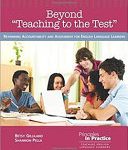 Beyond “teaching to the test”: Rethinking accountability and assessment for English language learners
Beyond “teaching to the test”: Rethinking accountability and assessment for English language learners
by Betsy Gilliland and Shannon Pella
Grades: K-12
This book gives teachers the background and strategies to make their teaching and support equitable for ELLs. Examining how teachers can support learners’ reading, writing, and academic language development, and illustrated with examples of real teachers at work, the authors explain teaching for accountability, formative and summative assessment, and preparation for high-stakes testing, as well as provide suggestions for teaching, guiding questions for discussion, and resource recommendations. Part of the Principles in practice series.
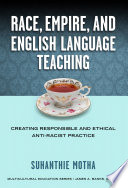 Race, empire, and English language teaching: creating responsible and ethical anti-racist practice
Race, empire, and English language teaching: creating responsible and ethical anti-racist practice
by Suhanthie Motha
This timely book takes a critical look at the teaching of English, showing how language is used to create hierarchies of cultural privilege in public schools across the country. Motha closely examines the work of four ESL teachers who developed anti-racist pedagogical practices during their first year of teaching.
Finding More Resources
To find more resources in this area, try the following:
- Search using the General tab on the UBC Library website to look for material in all UBC Library branches.
- Search using “Search Education Resources” box in the left hand bar on the Education Library website to limit your results to physical materials in the Education Library.
- Use specific search terms to narrow your results, such as “English language–Study and teaching–Foreign speakers”.
- To find lesson plans, include “lesson plans”, “lesson planning”, or “activity programs” in your search terms.
For more help with searching, please visit the Library Service Desk or e-mail ed.lib@ubc.ca.

